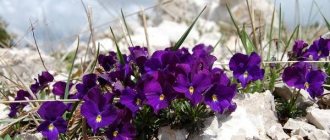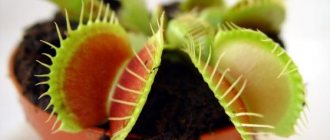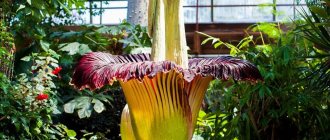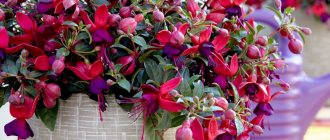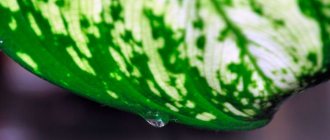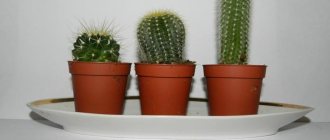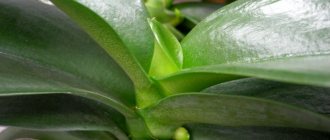The phalaenopsis orchid is rightfully considered one of the most common plants in home floriculture.
This is facilitated by the extraordinary variety of colors and shapes of flowers, abundant and lush flowering, and ease of care. Knowledge of the growing conditions of these tropical plants and compliance with the rules for their maintenance are a condition for good growth and regular flowering of the orchid.
In this article we will look at one of the unusual species of phalaenopsis called Phalaenopsis Giant.
Giant phalaenopsis orchid
Giant Phalaenopsis (Phalaenopsis gigantea) is the largest representative of monopodial orchids of the Phalaenopsis genus.
It received its name for its unusually large drooping leaves , reaching a length of 1 m.
A distinctive feature of the giant phalaenopsis is its large leaves.
Like all orchids, giant phalaenopsis is an epiphytic herbaceous perennial , perfectly adapted to growing in tropical forests.
F. Schiller (Phalaenopsis Shilleriana)
Growth.
Philippines. Luzon (provinces: Albay, Quezon, Rizal and Sorsogon) and other smaller islands.
Description history.
The first mention of Phalaenopsis schilleriana belongs to Mr. Seeman, published in June 1856. He wrote about the Brussels greenhouses of Linden, and briefly described a plant that could well be Phalaenopsis schilleriana.
The first plant imported into Europe belonged to Schiller, who worked in Manila as a consul from Hamburg. In 1859, he purchased 30 plants from orchid collector Marius Porto, who worked for Linden's company. Of Schiller's entire collection, only one plant reached Europe.
The species was described by Reichenbach in 1860. Phalaenopsis schilleriana was imported into England in 1862. In Europe, this plant was the dream of many collectors; a non-flowering specimen was easily valued at 100 guineas. By 1875 the price had fallen, with flowering specimens costing 32 guineas, but demand continued to be high.
The plant is named after the German consul and orchid collector Schiller.
Biological description.
Monopodial epiphyte of medium size.
The stem is short, hidden by the bases of 3-7 leaves.
The roots are well developed, thick, flattened, gray in color with greenish-brownish tips.
The leaves are oblong-elliptical, obtuse, dark green, with a beautiful marbled silver-gray pattern on the surface, the bottom surface of the leaves is darker with a red-violet tint. Their length is 25-50 cm, width 7-12 cm. With a lack of light, the marble pattern fades.
The peduncle is annual, red-brown, drooping, branched, up to 1 meter long. The number of flowers depends on the age and habit of the plant; it can bear up to 400 flowers at a time.
The color of the flowers ranges from soft to dark pink, some clones have an aroma comparable to that of lilac, up to 9 cm in diameter, and open almost simultaneously. The lip varies in color from white-green to red-violet.
Features of the view
The stem is shortened, hidden under the bases of the leaves. The roots are fleshy, smooth, dense.
The leaves are leathery, very wide, drooping, with a shiny surface, rounded at the ends. An adult plant has 2-3 pairs of leaves about 0.6 m long, up to 0.4 m wide, sometimes the leaf length reaches 1 m.
The peduncle is hanging, curved, prone to branching, grows in length up to 0.3-0.4 m, bears from 10 to 30 flowers.
The flowers are fleshy, dense, with a diameter of 3.5 to 7 cm; thanks to the petals of the same size, they have a regular round shape.
The color of the petals is presented:
- Light cream,
- Green-yellow,
- Yellow color,
There are numerous red-brown lines , which can be easily felt with your fingers.
Phalaenopsis gigantea.
The flowers have a light citrus aroma . An adult orchid can easily form up to 100 flowers on several flower stalks.
F. Parishii (Phalaenopsis Parishii)
Growth.
Eastern Himalayas - Myanmar, Assam India, Thailand and Vietnam.
Description history.
Discovered in Myanmar in 1864 by Reverend Father Samuel Parish, who served as rector of the local church and was an avid orchid lover.
Parish sent the found specimens to Messer Law's company at Kew Botanical Gardens. In 1865, a description of the plant compiled by Heinrich Gustav Reichenbach appeared in the Botanical Newspaper.
Biological description.
Miniature monopodial deciduous epiphyte. The root system is well developed, the roots are flat, smooth, branching. The stem is short, completely covered with leaves. There are 1-3 leaves, they are succulent, paired, dark green, elongated oval, 5-17 cm long, about 5 cm wide.
The peduncle is short, usually does not exceed the length of the leaves, erect or oblique, flat, 5-14 cm long, appears from the base of the stem, bears 4-10 flowers. There may be several flower stalks.
The flowers are fragrant (fruity-candy smell during the day), long-lived, about 2 cm in diameter, bloom simultaneously, last 15-20 days. The flowers are milky white with a very wide lip.
The middle lobe of the lip is purple or purple-lilac, the semicircular plate in its center along the edge is fringed or with long cilia.
The flowering season in nature is spring.
A closely related species is Phalaenopsis gibbosa.
Habitat
The homeland of this extraordinary plant is Fr. Borneo in Indonesia .
Giant phalaenopsis grows high in the canopy of trees growing in tropical forests on mountain slopes.
This region is characterized by the absence of seasonal fluctuations in temperature and humidity : the range of daily temperature changes is within 23℃ at night and 30℃ during the day, relative air humidity: 80-86%.
The natural growing conditions of the giant phalaenopsis have left their mark on the care of this plant when kept indoors.
When you type in a photo of “gigantella” in the search, you will have to try to find a picture of a natural orchid, since there is no limit to the crossing of giants and there are a lot of photos of hybrids.
Description of rhynhostylis
Rhynhostilis got its name from the flower column, which resembles a bird's beak. The plant lacks a pseudobulb. During life, only one vertical shoot develops; the stem is thick and dense. The lower leaves fall off as they grow, and powerful aerial roots are formed in their axils, which are covered with a thick layer of velamen. The leaves are paired and belt-shaped, reaching 30–35 cm. The leaf blades are dense, light or dark green in color, the tips are slightly “torn.”
Peduncles are long, erect or drooping. Each bears many buds. The flowers are small, varied in color and smell pleasant. The buds in the inflorescences-tassels open sequentially. Rhynhostilis blooms all year round, so rest is not needed. The flowering period lasts 2–3 or 5–6 weeks. The older the plant, the more flower stalks it produces.
History of discovery
Phalaenopsis giant was discovered at the end of the 19th century by the naturalist Nyvenhuis. He transported the plant to the botanical garden of the city of Buitenzorg, where the orchid first bloomed in 1909.
The unusual plant was described by the director of the botanical garden, J. Smith, after which the plant soon died .
During the construction of the road to the island. Barneo in 1937, the giant phalaenopsis was found again .
Currently, as a result of human economic activity, this species has been practically destroyed in its natural habitat.
Growing
Rhynhostylis has a negative attitude towards transplants. Therefore, the container is replaced only in cases of extreme necessity: when the root system grows or the substrate is completely decomposed. It is best to replant the plant in April. If the flower is grown in a pot, then at least a third of the volume should be occupied by a drainage layer. It is very important to place the orchid in the same place as it was before the transplant. The method of open cultivation is also suitable for Rhynhostilis: in hanging baskets without substrate.
In indoor floriculture, Rhynhostilis are propagated by lateral shoots. They can be separated only after the formation of “own” roots.
Features of flowering
This type of phalaenopis is considered one of the most demanding in culture. It is characterized by very slow growth, which is why the cost of adult specimens is extremely high.
In nature, the plant blooms after 6-12 years , but with proper care in cultivation, this period can be significantly reduced and amount to about 4-5 years. The first flowering of an orchid can be expected when the length of the leaf blade reaches 25 cm.
Important! If you decide to purchase this extraordinary plant for your collection, choose, if possible, the oldest specimen.
Peak flowering of the giant phalaenopsis occurs in late summer and early autumn , although it can bloom at any other time of the year. Flowering is long, up to 25-30 days, without a pronounced dormant period.
Photo of a blooming Gigantea, which grew in a greenhouse at t=27 C and 75-98% humidity during the day. The largest flower is 5 cm. More photos of this handsome flower from its owner can be found on the forum.
And this is what the giant’s flower looks like from the photo above.
A faded flower stalk should not be cut off , since the old flower stalk is characterized by repeated flowering.
About prices for exotic handsome giants
The larger the plant, the higher its market price. Mature plant specimens cost between $100-$200. Plants that, for example, have a year left before flowering, can cost from 75 euros. Seedlings - about 20 euros.
Not all lovers have the opportunity to buy an adult plant. You have to wait less for a teenage plant to bloom than a seedling, but it will also cost much more. Everyone chooses a plant based on personal capabilities. Many orchid growers purchase seedlings from collectors and grow them to bloom.
Landing
Thanks to its decorative properties and the ability to easily cross with other varieties and hybrids , giant phalaenopsis has gained immense popularity and is successfully grown in botanical gardens, greenhouses, and also in apartments.
Priming
Like all orchids, it loves light, nutritious, breathable soil. When transplanting, the substrate should easily fall off from the roots .
As a rule, it consists of:
- Pieces of pine bark 2-3 cm in size;
- Expanded clay;
- Wood (preferably birch) charcoal;
- Whole sphagnum moss.
also purchase a ready-made substrate in a specialized store by adding a few threads of whole moss to it.
Sometimes phalaenopsis in a basket is grown on pure New Zealand moss . In such a substrate, the plant can grow without replanting for many years.
Optimal capacity
Plant a giant phalaenopsis in an orchid pot , basket or on a block.
A transparent pot for the still little Giant.
When choosing a pot, you should pay attention to its characteristics:
- Mandatory presence of drainage holes;
- The volume of the pot should be such that the roots are freely located and do not touch the walls;
- The material of the container must have good heat-insulating properties, otherwise the roots will overheat;
- Transparent walls will allow you to observe the condition of the root system.
A giant phalaenopsis planted in an orchid basket or block looks very impressive , since in this case its growth is similar to growing in natural conditions.
However, it must be borne in mind that growing on a block is inconvenient due to the large size of the plant and the need for daily watering.
Craftsmen also cultivate Giant Phalaenopsis entirely in water.
Growing Gigantea in water.
And here is a video on this topic, albeit in English (about growing in water starts approximately from the middle of the video):
Priming
The best way to grow a large phalaenopsis is one that is convenient and suitable for both the plant and its owner. Large specimens grow well in baskets with sphagnum moss. This method allows you to avoid damaging the plant by replanting for several years. The container is hung on the wall or tilted at an angle of 45 so that the leaves hang down freely.
Many collectors like to place the beautiful giantea on a block. In this case, its root system is also covered with moss. An important feature of both methods is the need for more frequent watering. Both the basket and the block dry out much faster.
A closed system in a plastic pot allows you to reduce the frequency of watering. The soil in this case usually consists of bark and sphagnum moss. You can make it yourself from individual components or use a ready-made mixture with additives in the form of coconut chips. Coconut is a moisture-intensive, voluminous material that does not allow the bark to cake. Soil with coconut retains its breathable properties and optimal moisture for a long time. Coconut fiber can also be used as drainage. In this case, additional moss will need to be placed on the surface of the soil in the pot. The soil should be completely dry between waterings.
In order to resuscitate and accelerate the growth of the root system, it is better to place very small plants in a substrate consisting only of moss. Or create a kind of “greenhouse”: place the pots in a larger container, for example, an aquarium. Cover the system with film, not forgetting to periodically “ventilate” several times a day. Place this structure on the south side of the room - where it is always sunny. It is necessary to water only when the substrate is completely dry.
Peculiarities
The roots of giant phalaenopsis are very sensitive to injury , so transplantation is done only if necessary.
is replanted every 3 years after flowering has ended. The best time to transplant is the warm season, when it grows intensively.
Important! Planting is carried out in such a way that all the leaves of the plant hang down. This will protect the growing point from stagnant moisture after watering. Otherwise, transplantation is carried out according to the same rules as for other types of phalaenopsis.
After transplanting, it is recommended not to water the orchid for 2 weeks so that the plant adapts to the new conditions.
Watering: general recommendations
Creating comfortable, high-humidity conditions for plants of similar sizes at home is quite a difficult task.
But in the case of gigantea in general, we can still say that it is not too demanding on watering. Hard (dechlorinated) water from the general water supply system is perfect for her. In case of irrigation with water without salts (for example, distilled or after reverse osmosis filters), it is necessary to use complex fertilizers. They allow you to maintain the desired salt concentration, thus ideally adapting the water to the physiological state of the plant. Prolonged watering with desalted water without additives leads to the development of various diseases, including parasitic infections.
Often the causes of diseases are not associated with water quality. Their connection is not obvious due to the fact that the salt reserve in the tissues is gradually depleted.
Watering is done as the substrate dries, on average once a week or every 3-4 days. When watering weekly, it is advisable to add diluted fertilizer (four times the recommended dose) each time. If watering is more frequent, you can feed during every fourth or fifth watering. The rest of the time, use regular tap water.
Both mineral and organic fertilizers are suitable for feeding. Special formulations have also been developed and offered that enrich demineralized water. You can purchase them from the owners of orch farms in Asia and Europe.
Care
The giant phalaenopsis is very indoor conditions
Optimal conditions of detention
For good growth and normal flowering when kept indoors, it must be provided with favorable growing conditions:
- The optimal cultivation temperature is in the range of 22-30℃ with a mandatory daily temperature fluctuation of 5-8℃. The plant does not tolerate well if the room temperature drops below 15℃;
- Lots of diffused light, much more than most other orchid species. In winter, the orchid is placed on the brightest window, as it grows all year round;
- The required indoor air humidity is 60-85%. To maintain optimal humidity, you can use a humidifier or place the orchid pot on damp expanded clay;
- The plant loves good air circulation so that moisture quickly evaporates from the leaves.
If you create favorable conditions for the giant phalaenopsis, it will reward you with good growth and extraordinary flowering .
Here's another giant. Other photos and description of this specimen can be found here.
Advice! If the orchid is not growing well, pay attention to the lighting. The right location plays an important role in the health and well-being of the plant.
Replanting after purchase
After purchase, phalaenopsis is not recommended to be replanted . This can only be done if rotten roots are visible.
It is better to place the plant in diffused light , away from other indoor plants. At first, it is not recommended to water or feed it .
If no diseases are detected during quarantine, then after 10 days the plant can be placed in a permanent place and watered.
Watering and fertilizing
Like other types of orchids, giant phalaenopsis is very sensitive to watering:
- Water the phalaenopsis as the substrate dries. It is better to do this in the morning so that the water that remains on the leaves dries by the evening. Watering is carried out once every 7 days, and care is taken not to cause waterlogging of the substrate;
- To water, place the pot with the plant in a container filled with water to 2/3 of the height of the pot and leave to stand for 15 minutes. After the roots are saturated with water and have acquired a bright green color, the pot is placed on the surface for 30 minutes to allow the water to drain;
- A good outflow of water can be ensured by placing the pot at an angle of 35-40°;
- If there is insufficient lighting in winter, the regime of watering and feeding the orchid is reduced.
Attention! It is necessary to ensure that water does not accumulate at the growth point of the giant phalaenopsis, as this can lead to rotting of the orchid.
Fertilizing is carried out with highly diluted orchid fertilizer.
For phalaenopsis growing on different substrates, different types of fertilizers are used:
- On a substrate of living sphagnum moss, foliar feeding with fish fertilizer is used (0.1 teaspoon per 3.8 liters of water). In this case, you cannot use chemical fertilizers, this can lead to the death of the substrate;
- On a bark substrate, the plant is fed with ½-1/4 doses of orchid fertilizer.
Feeding is carried out during every third watering of phalaenopsis .
Stimulating flowering
To stimulate the flowering of giant phalaenopsis, the plant needs daily temperature fluctuations .
Optimal differences should not exceed 5-8 ℃: from 30-31 ℃ during the day to 22-23 ℃ at night.
Attention! The main condition for regular flowering of an orchid is optimal maintenance conditions and proper care.
Prevention of diseases and pests
In order for the orchid to grow healthy, it is necessary to ensure that water does not fall on the leaves when watering and does not stagnate in the leaf axils , as this can cause bacterial rot.
Rotting of the growing point is especially dangerous . To prevent this from happening:
- After watering, the water from the surface of the leaf must be blotted with a paper napkin;
- To prevent water from accumulating at the base of the leaves, it is better to place or hang the container for orchids at an angle of 40-45o.
On rainy days, after watering, a fungicide can be sprayed to prevent rotting.
How to adapt to home conditions
It should be replanted from the substrate as soon as the plant arrives from the flower shop at home. In fresh substrate, roots grow much faster. It is first recommended to soak the roots in a solution of Fitosporin with Zircon for 30 minutes. After drying for an hour, plant in the system: expanded clay, substrate and a little moss on top.
It is better to regularly replace the substrate every 3-4 months. Especially if fertilizers are used as top dressing. This way the soil will not have time to acidify and negatively affect the roots of the plant.
The container should be selected strictly in accordance with the size of the roots. If the size of the orchid is, for example, 1.7 cm, then it should not be transplanted into a glass that is too large. Otherwise, the substrate will dry out too slowly, and the risk of rotting of the soil and roots in the pot will increase sharply.
If there is not enough seasonal lighting, it makes sense to install additional lighting in the form of phyto- and conventional lamps. The distance from the lamps to the leaves should not be too large - no more than 10 cm. Then the plant begins to quickly grow leaves and root system.
Gigantea has a thin leaf plate, the slightest overheating has an adverse effect. The plant slows down its growth rate and shows signs of dehydration. As an auxiliary measure, a fan is installed with air supply in the upward direction. Thus, the ambient temperature will be maintained at an optimal level. Airflow helps to increase growth rates, especially in young plants.
Reproduction methods
Giant phalaenopsis reproduces vegetatively with the formation of babies on a flower-bearing arrow or stem.
On the right side of the photo you can see a baby Gigantea on a peduncle.
At home, this happens extremely rarely , only if the plant is in ideal conditions with high relative humidity and heat.
Bacterial rot: causes and methods of control
Compared to other species, giant phalaenopsis has a very short stem. The distance between its leaves is very small, and sometimes completely absent. Therefore, it is important to avoid getting water into your sinuses. Its prolonged stagnation on any part of the leaf and stem is especially dangerous. Water accumulated between the leaves inevitably provokes rotting. Bacterial rot that affects the growth point is extremely dangerous.
In order not to provoke stagnation of moisture, it is better to exclude spraying as a method of watering.
The following will help prevent the development of rot:
- hanging the pot so that the leaves hang down at an angle;
- early watering - so that by the evening the remaining moisture is completely dry;
- using a fan for better air circulation and blowing;
- using an air compressor when watering in cloudy or rainy weather;
- turning off humidifiers in the afternoon and at night;
- drying the socket with paper napkins;
- use a fungicide solution after each watering.
Varieties and hybrids of Giant Phalaenopsis
Giant phalaenopsis easily hybridizes with other varieties of orchids and their hybrids. Here is a list of some primary Gigantea hybrids:
You can see their photos using this link.
He passes on to his offspring such valuable qualities as:
- A large number of flowers on a peduncle,
- The correct shape of the petals,
- Bright coloring with large dots and strokes.
One of the most unusual hybrids is Gigantea alba ( Phalaenopsis gigantea alba), an extremely rare and expensive variety of phalaenopsis, presented in 2012 at an exhibition in America.
Phalaenopsis gigantea alba.
The plant has waxy whitish flowers with green spots.
A healthy orchid is capable of producing about a hundred 5-6 cm fragrant flowers on branching peduncles.
Transfer
No different from transplanting ordinary phalaenopsis. The preferred time of year for this procedure is the warm months when the plant is actively growing. A substrate mixture based on pine bark is prepared in advance. You can also use a ready-made substrate with the addition of moss or coconut particles. A small amount of drainage and several fragments of large bark are placed at the bottom of the pot. The plant placed in a new pot is covered with finer bark with a small addition of moss. The roots can be sprinkled with mycorrhizal spore seeds, a natural growth activator.
The moss contained in the pot often gives the roots a distinctive yellow-brown color. This is a normal phenomenon and is not related to the condition of the roots.
A new pot lasts for a year or two, and then another replanting is required. If the plant is transplanted into a container with holes, it is better to seal them in the future. Gigantea loves moisture; if it is not enough, the roots can dry out.
Secrets of success
A large amount of light with indispensable protection from direct sunlight is a prerequisite for the comfortable existence of Rhynhostilis. In this case, it is necessary to extend the daylight hours to 10–12 hours. Fluorescent lamps will help make up for the lack of natural light.
Rhynhostilis love warmth, but are ready to put up with coolness. In summer they feel good at +25–28°C. An increase in air temperatures does not affect the decorative appearance and health of plants if they are provided with additional watering. In winter, temperatures down to +12°C are acceptable. The natural difference in day/night temperatures fully satisfies the needs of these orchids.
Rhynchostilis need high air humidity. However, spraying requires a fair amount of skill: the drops should not fall into the axils of the leaves. Installing humidifiers and regular ventilation help solve the problem. But it is important to remember that excessive moisture at low air temperatures is dangerous. The risk of dampness and pathogenic microflora increases. Therefore, it is important to maintain a balance: higher temperature - higher humidity.
Rhynhostilis have no periods of rest, so they are watered all year round. You should use water at room temperature, settled or boiled. After flowering and in winter, the amount of liquid should be reduced.
From the beginning of spring to mid-autumn, Rhynhostilis are fed with complex fertilizers for orchids. It is recommended to use a solution of low concentration, alternating root and foliar methods.
